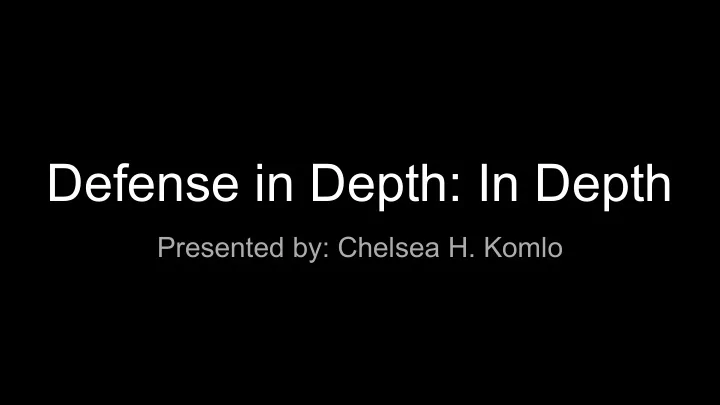

Defense in Depth: In Depth Presented by: Chelsea H. Komlo
About me - Software engineer, privacy and security engineer - HashiCorp, ThoughtWorks, Tor - Worked in 5 countries and two languages
About this talk - NOT how to do security - The purpose of this talk to discuss how to think defensively about your system at every level.
What I often come across when talking about security
You could have the most awesome encryption standard, but pressing the enter key could sidestep all authentication.
One vulnerable third-party library leads to hundreds of millions of sensitive PII being stolen
Security is holistic.
Defense in depth is necessary for a secure system Goal: One vulnerability won’t result in compromising the entire system.
We’ll look at defense in depth from a variety of viewpoints - Low level (code) - Mid level (teams) - High level (architecture) - Highest level (product strategy)
Defense in depth: Code - Maintain code quality - Leverage automated tooling - Meaningful automated tests
Defense in Depth: Maintain code quality - Antipattern: Making assumptions when writing code. - Pattern: Code should written defensively - Takeaway: Security vulnerabilities are bugs!
Example: Brittle code // Should never be called with nil func sayName(p *Person) { fmt.Printf(“%s”, p.Name) }
Defense in Depth: Leverage automated tooling - Antipattern: Minimal compile-time validation - Pattern: Enable language-specific compile-time checks - Takeaway: Humans fail! Leverage automated tooling where possible
Example: Automated code analysis - Go Race Detector - ASAN - GCC: -Wall -Wextra
Defense in Depth: Meaningful automated test cases - Antipattern: Adding a single test case for a function - Pattern: Having test cases that exercise your code with varying granularity. - Takeaway: Don’t be single-dimensional in your tests!
Testing at multiple levels: - Unit - Integration - E2E - Soak - Time-based - Fuzzing
Defense in depth: Teams - No more “rock stars” - No “throw over the wall” security requirements
Defense in Depth: No more rock stars - Antipattern: Someone on the team pushing lots of code to master without a review. - Pattern: All code goes through thorough code review (from anyone on the team) - Takeaway: Security is a team sport!
Defense in Depth: No “throw over the wall” security requirements - Antipattern: Long list of requirements from your security team. - Pattern: Development teams and security teams closely collaborating. - Takeaway: Collaborate.
Defense in depth: Architecture - Managing evolution cleanly - Automate infrastructure
Defense in Depth: Manage evolution cleanly - Anitipattern: Layers of “cruft” and deprecated features. - Pattern: Remove deprecated code paths, strive for minimal branching. - Takeaway: Your attacker will know your system better than you will!
Example: OpenSSL versus OpenBSD’s LibreSSL Over 90,000 lines of code removed.
Defense in depth: Automate infrastructure - Anitipattern: Bespoke, artisanal server management. - Pattern: Use automated tooling to manage your cluster. - Takeaway: The less manual effort, the fewer “forgotten holes.”
Example: Cluster schedulers for Secops
Defense in depth: Product Strategy - Privacy and security serve the same ends - Consider your users’ threat model
Defense in Depth: Privacy and security serve the same ends - Antipattern: Collecting all possible data - Pattern: Collect only what is strictly necessary - Takeaway: Strive for privacy by design, as opposed to retroactive privacy.
Example: Encrypted messaging applications
Defense in Depth: Consider your users’ threat model - Antipattern: Planning for only your organization’s security needs - Pattern: Consider every user’s needs, including at-risk users in your threat model - Takeaway: Be aware of decisions that place users at greater risk
Example: Sensitive data and third parties
Example: Consider vulnerable users
Security must be holistic! This means all roles, all people, working together thoughtfully. There is no partial credit in security!
Thank you!
Recommend
More recommend